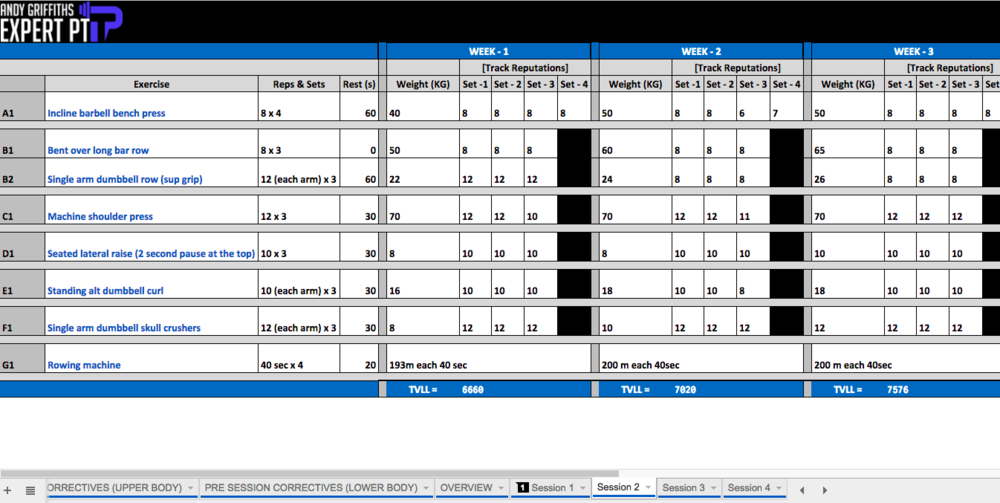What Is Progressive Overload?
“Progressive overload requires a gradual increase in volume, intensity, frequency or time in order to achieve the desired goal of the user. In this context, volume and intensity are defined as follows: Volume is the total number of repetitions multiplied by the resistance used as performed in specific periods of time.”
Progressive overload is absolutely key to your training programme, regardless of your goal, be that strength, hypertrophy or endurance. Without progressive overload, your body will progress and develop to a point, but if you want to see further development then you need to exert greater demand on the body by training hard and training smart. If you don't progressively overload the muscles by forcing them to do more than they're accustomed to, then they have no reason to make further adaptations.
Think about it this way, if you go to the gym and do the same exercises with the same amount of reps, sets and resistance, then run 1km at the exact same pace each time, do you think your body will develop? Does it need to?
The answer is NO, your body will not develop unless it needs to! The body needs to be incrementally challenged in a structured manner in order to see continuous improvements in performance.
To effectively overload the muscles, you need to implement these methods:
1. Increase Load/Resistance
Increasing the resistance/load is the most common and effective way of progressively overloading a muscle. To give you an example, week one you complete 4 sets of 8 reps on the back squat using 100kg and week two you perform the same amount of reps and sets, but you increase the load up to 110kg, this is the simplest form of progressive overload, progressively increasing the load in order exert greater demand on the muscles.
2. Increase Reps
Consider our example of the back squat again, instead of adding additional load, you could instead perform 4 sets of 10 reps, rather than the initial 8 reps.
Note that with this method, you're limited as you should train within certain rep ranges specific to your goals, for example, if you were training for strength you would not want to incrementally increase the reps until you're hitting 15 + reps as you would then be moving towards muscular endurance. You would increase another variable, like load, frequency or time as this is more aligned to your goal.
On that note, below are the recommended rep ranges for several common goals:
Strength 4-8 reps
Hypertrophy (muscle building) 8-15
Muscular endurance 15 reps +
These are based on the conclusions of a meta analysis by Brad J Schoenfield et al, who found that lower reps with higher weight leads to increased strength, whereas higher reps with lighter weight led to hypertrophy. As you’d imagine, the rep range for endurance is the highest, which echos the findings of a randomised controlled trial by Gerson E Campos et al from the European Journal of Applied Physiology, who found that higher rep ranges lead to the individuals who are better adapted for submaximal prolonged contractions and increased aerobic power and time to exhaustion.
3. Increase Volume
Volume is simply sets multiplied by reps multiplied by resistance. You can increase demand on your body and muscle groups by adding more exercises, reps or sets. Instead of performing the 100kg back squat for 4 sets of 8 reps, you can do it for 5 sets of 8 reps. Alternatively, you can lift the same weight, reps and sets, but add in an additional exercise that targets the same muscle group, for example, you could superset your back squats with lunges..... if you're feeling brave.
In a review by William J Kraemer et al from The American College of Sports Medicine, it was recommended that changes in total training volume (reps, sets, load) be made in increments of 2.5% to 5.0% per week to avoid the possibility of overtraining.
4. Increase Frequency
Increasing the training days per week is a very simple and effective approach, but is limited as you need to take sufficient rest days in order to recover and grow. Training needs to enrich your life, not take over it and overtraining can have a detrimental effect on your progress.
5. Reduce Rest Between Sets
This is one of my personal favourites, especially with busy clients who have limited time per session to train. It’s a great way to achieve more volume per session, equating to a significant increase in total volume per week. This can be achieved either through less rest between sets, or by using a training system, such as supersets or tri-sets, where there is no rest between different exercises. This allows you more time to adequately train multiple muscle groups within a session but sets per muscle group should be kept at an appropriate, optimal level for you. The only drawback to limiting rest relates to those training specifically for strength gains; it's vitally important that you have adequate rest between sets in order to sufficiently recover for the next heavy set - you’ll need to be ready for it.
What have we learned?
First and foremost, progressive overload is key, regardless of your goal; it’s the catalyst for seeing real progress and pushing the body to do more. There are several ways in which to elicit progressive overload at our disposal, but it’s vital these are fully understood so you can engage the method which is best aligned to your goals, lifestyle and training experience.
If you are looking for an Online Personal Trainer who can provide a bespoke training plan, with progressive overload at its core, sign up today.






